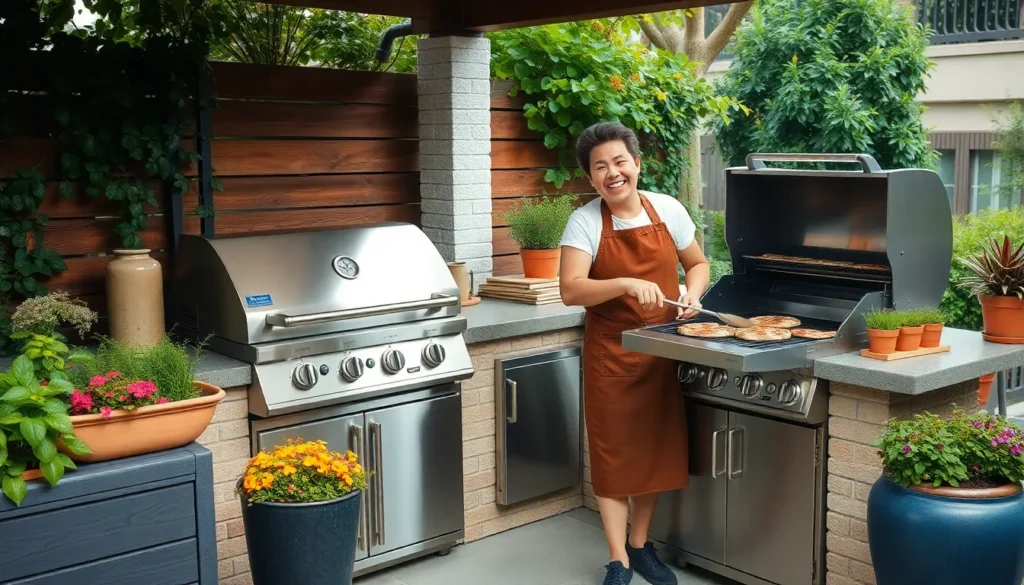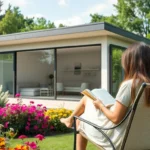We’ve all dreamed of cooking and entertaining in perfect harmony with nature. Garden kitchens transform ordinary outdoor spaces into culinary havens where fresh herbs grow within arm’s reach and dinner parties flow seamlessly from indoor to outdoor living.
The concept isn’t just about placing appliances outside – it’s about creating a functional cooking space that celebrates seasonal ingredients and connects us to our food sources. Whether you’re planning a simple herb garden adjacent to your outdoor cooking area or designing an elaborate outdoor kitchen surrounded by raised vegetable beds, the possibilities are endless.
From compact urban balcony setups to sprawling backyard installations, garden kitchens offer answers for every space and budget. We’ll explore innovative design ideas that blend practicality with natural beauty, helping you create an outdoor culinary sanctuary that enhances both your cooking experience and your garden’s productivity.
Create an Outdoor Cooking Station With Essential Appliances
Building a functional outdoor cooking station requires selecting appliances that enhance our garden kitchen experience while withstanding outdoor conditions.
Built-In Grills and Smokers
Built-in grills transform our outdoor space into a permanent cooking destination that rivals indoor kitchens. We recommend choosing stainless steel models with BTU ratings between 40,000-60,000 for optimal performance. Gas grills offer convenience with instant ignition and precise temperature control, while charcoal options provide authentic smoky flavors.
Smokers elevate our garden cooking with low and slow techniques perfect for brisket, ribs, and vegetables. Electric smokers maintain consistent temperatures between 225-250°F without constant monitoring. Wood pellet smokers combine convenience with natural flavors, automatically feeding pellets to maintain desired heat levels.
Professional-grade built-in units feature multiple cooking zones, rotisserie attachments, and integrated storage. We suggest positioning these appliances near our herb gardens for easy access to fresh seasonings during cooking.
Outdoor Pizza Ovens
Outdoor pizza ovens create restaurant-quality results while becoming stunning focal points in our garden kitchens. Wood-fired ovens reach temperatures of 800-900°F, cooking pizzas in just 90 seconds while imparting distinctive smoky flavors.
Modular pizza oven kits simplify installation without requiring masonry expertise. These pre-fabricated units include insulated chambers, chimney systems, and weather-resistant exteriors. Gas-powered options offer consistent heat control for beginners, while traditional wood-burning models provide authentic Italian cooking experiences.
Portable pizza ovens expand our cooking options without permanent installation. Countertop models heat up in 15-20 minutes and accommodate 12-inch pizzas. We can also use these versatile ovens for baking bread, roasting vegetables, and preparing casseroles.
Portable Induction Cooktops
Portable induction cooktops bring precise cooking control to our outdoor spaces without requiring gas lines or electrical hardwiring. These units heat cookware directly through magnetic fields, achieving faster cooking times than traditional methods.
Commercial-grade portable induction units feature power levels from 1,800-3,500 watts with temperature controls ranging from 140-460°F. We recommend models with digital displays and preset cooking programs for consistent results. Weatherproof designs withstand outdoor conditions while maintaining safety features like automatic shut-off.
Battery-powered induction cooktops eliminate cord limitations, operating for 2-4 hours on single charges. These cordless options perfect our garden cooking flexibility, allowing us to position cooking stations anywhere in our outdoor space. Dual-burner models accommodate multiple dishes simultaneously, expanding our outdoor menu possibilities.
Design a Functional Prep and Storage Area

Smart preparation and storage answers form the backbone of any successful garden kitchen. We’ll explore essential components that maximize efficiency while withstanding outdoor conditions.
Weather-Resistant Countertops
Granite stands as our top choice for outdoor counters, offering unmatched durability against weather extremes. Baltic Brown granite integrates seamlessly into garden surroundings while providing the robust surface we need for food preparation. Stainless steel countertops deliver a modern aesthetic and superior weather resistance, making cleanup effortless after cooking sessions.
Natural stone options like granite resist staining and scratching better than traditional indoor materials. Weather sealed edges prevent moisture infiltration that could damage the counter structure over time. Professional installation ensures proper drainage slopes that redirect rainwater away from preparation areas.
Outdoor Cabinetry Answers
Danver Cabinets represent the gold standard for outdoor kitchen storage, engineered specifically to handle temperature fluctuations and moisture exposure. These specialized units feature marine grade hardware and weather sealed joints that protect our cooking essentials year round. Custom cabinet designs allow us to maximize awkward spaces and create storage answers customized to our unique garden kitchen layout.
Built in cabinet systems integrate with outdoor islands to create centralized prep stations that keep tools and ingredients within arm’s reach. Vertical storage maximizes our available space while keeping frequently used items easily accessible. Wall mounted cabinets free up valuable counter space for food preparation activities.
Herb and Spice Storage Systems
Vertical planters bring fresh herbs directly into our cooking space, eliminating trips to distant garden beds during meal preparation. These living storage answers enhance both functionality and visual appeal while providing the freshest possible ingredients. Built in spice racks protect our seasonings from moisture and temperature extremes that could compromise their potency.
Weather resistant spice containers with tight sealing lids preserve flavor integrity in outdoor conditions. Rotating spice rack systems maximize storage capacity within compact cabinet spaces. Dedicated herb drying stations allow us to preserve seasonal harvests for year round use in our garden kitchen creations.
Install Proper Water Access and Drainage
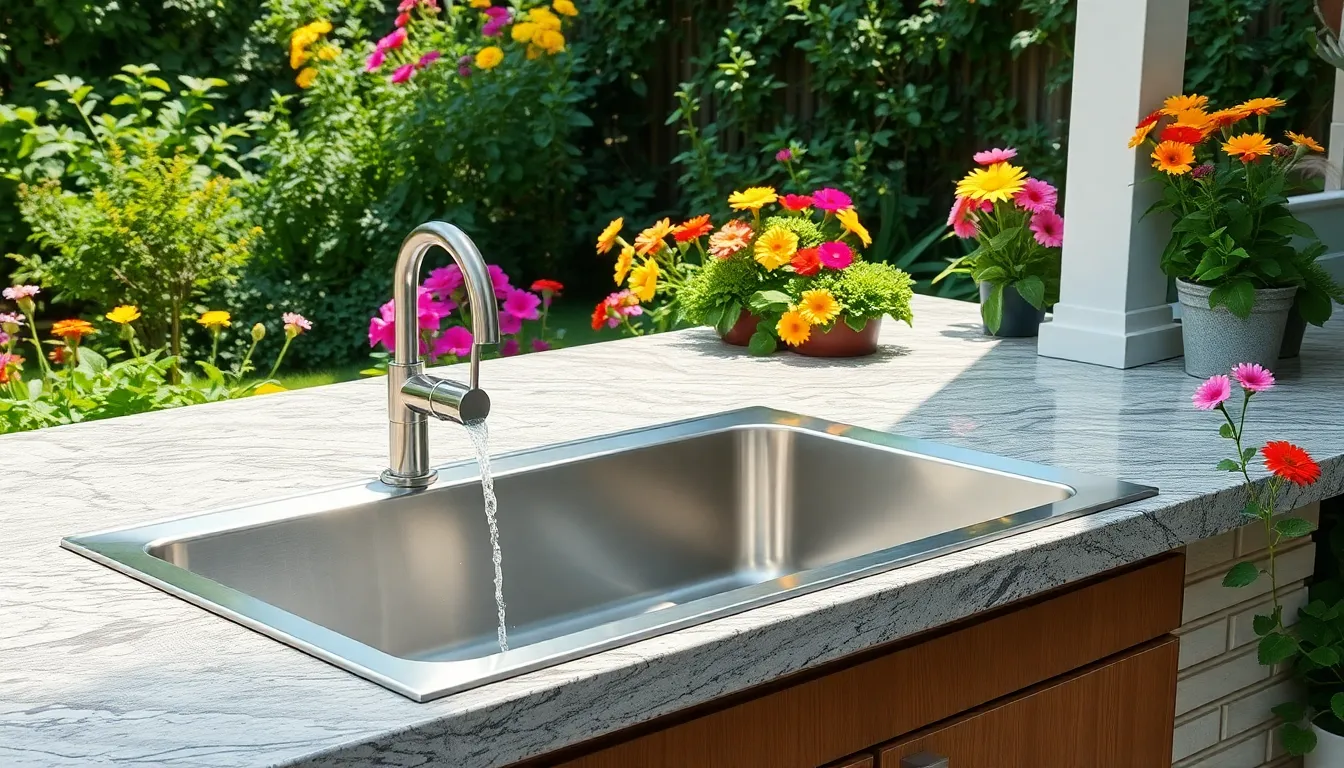
Water access transforms a garden kitchen from a basic outdoor space into a fully functional culinary environment. Drainage systems prevent water accumulation and maintain cleanliness throughout your cooking area.
Outdoor Sink Installation Options
Outdoor sink installation significantly enhances garden kitchen functionality by providing convenient water access for food preparation and cleanup. Connecting a garden hose to a faucet offers the simplest solution for rinsing vegetables and washing hands during grilling sessions. Built-in sink systems provide permanent water access with greater convenience and aesthetic appeal.
Multiple installation approaches accommodate different garden kitchen layouts and budgets. Portable outdoor sinks work well for smaller spaces or temporary setups. Permanent fixtures integrate seamlessly with countertops and cabinetry for a professional appearance.
Safety considerations require attention when installing outdoor water features. Water from outdoor sinks shouldn’t be used for drinking without proper treatment systems. Professional installation ensures proper connections and prevents potential plumbing issues.
Water Line Extensions
Water line extensions from the house create permanent water access for comprehensive garden kitchen functionality. Planning the route requires consideration of underground utilities and industry features. Professional plumbers ensure proper installation while maintaining water pressure and preventing freeze damage.
Trenching depth varies based on local climate conditions and frost line requirements. Insulated pipes protect against temperature fluctuations in colder regions. Shut-off valves allow seasonal water line drainage to prevent winter damage.
Cost factors include materials, labor, and potential industry restoration after installation. Permits may be required depending on local building codes and water line complexity. Professional assessment determines the most efficient route and installation method.
Drainage Planning
Drainage systems prevent water accumulation and ensure garden kitchen cleanliness through proper water management strategies. Manual drainage involves collecting sink water in containers for regular emptying. Greywater systems redirect used water for garden irrigation when local regulations permit.
French drains channel water away from the cooking area to prevent standing water issues. Slope planning directs water flow toward appropriate drainage points. Underground drainage pipes connect to existing home systems or designated runoff areas.
| Drainage Option | Installation Complexity | Maintenance Level | Cost Range |
|---|---|---|---|
| Container Collection | Low | High | $20-50 |
| French Drain | Medium | Low | $200-500 |
| Greywater System | High | Medium | $500-2000 |
| Underground Pipes | High | Low | $800-3000 |
Local regulations determine acceptable drainage methods and required permits. Building codes specify minimum drainage requirements for outdoor kitchen installations. Environmental considerations include water conservation and runoff management for sustainable garden kitchen operation.
Choose Durable Materials for Garden Kitchen Surfaces
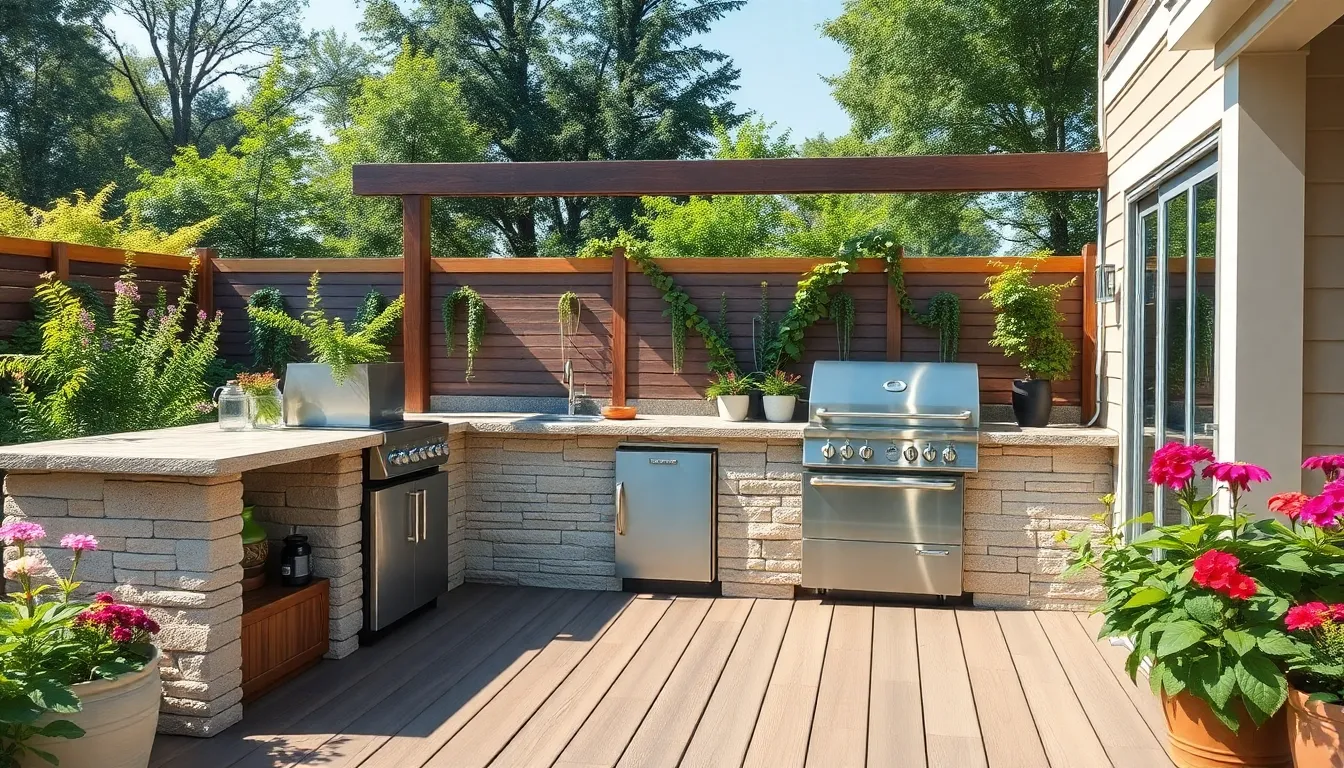
Selecting the right materials for your garden kitchen surfaces ensures longevity and minimizes maintenance requirements in challenging outdoor conditions.
Natural Stone Countertops
Natural stone countertops deliver exceptional durability that withstands harsh weather conditions year after year. Granite, marble, and quartzite offer superior resistance to outdoor elements while maintaining their beautiful appearance. We recommend these stone surfaces because they require minimal maintenance compared to other materials. Stone countertops resist staining, scratching, and temperature fluctuations that typically damage outdoor surfaces. Their natural beauty complements garden settings while providing reliable performance for food preparation tasks.
Stainless Steel Components
Stainless steel components resist corrosion and maintain their functionality in various weather conditions. We choose stainless steel for appliances, sinks, and hardware because it handles moisture exposure without deteriorating. Cleaning stainless steel surfaces requires only basic maintenance with standard cleaners. Steel components integrate seamlessly with both modern and traditional garden kitchen designs. Their non-porous surface prevents bacteria buildup, making them ideal for food preparation areas.
Composite Decking Materials
Composite decking materials combine plastic and wood fiber to create surfaces that resist rot and insect damage. We prefer composite materials for flooring and structural elements because they require less maintenance than traditional wood. These materials withstand moisture, temperature changes, and UV exposure without warping or splitting. Composite surfaces maintain their appearance longer than natural wood alternatives. They provide slip resistance and comfortable footing around cooking and prep areas.
Plan Strategic Lighting for Day and Night Use
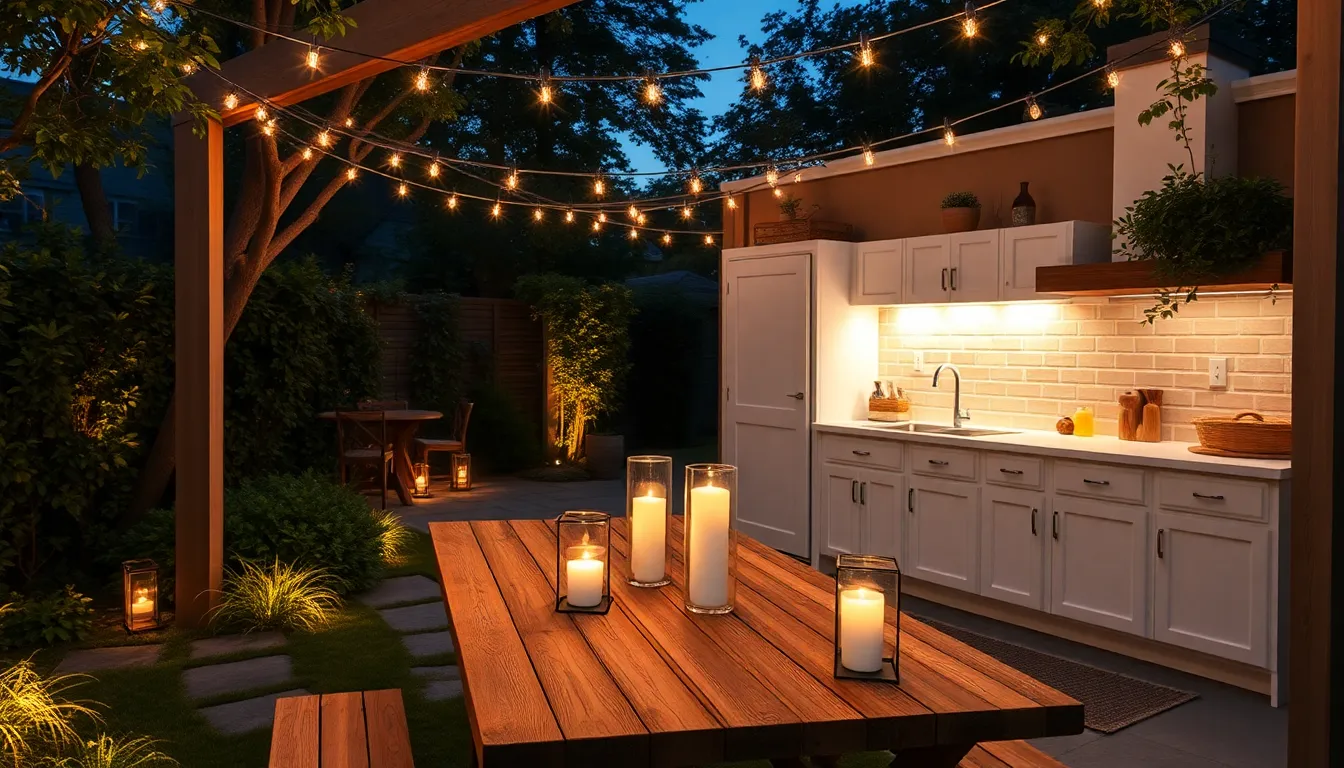
Proper lighting transforms your garden kitchen from a daytime cooking space into an enchanting evening entertainment area. We’ll explore lighting answers that ensure functionality while creating the perfect ambiance for outdoor dining experiences.
Task Lighting for Food Preparation
Under counter strip lights provide essential visibility for food preparation tasks in your garden kitchen. We recommend installing these focused lighting answers beneath countertops and around storage areas to eliminate shadows that can make chopping and prep work challenging.
Wall sconces mounted above grills and cooking stations deliver targeted illumination where you need it most. Position these fixtures at eye level or slightly above to prevent glare while ensuring adequate light reaches your cooking surfaces and cutting boards.
Focused lighting around prep areas prevents accidents and improves cooking efficiency during evening hours. Consider adjustable spotlights that you can direct toward exact work zones as your cooking tasks change throughout meal preparation.
Ambient Lighting for Dining
String lights create an inviting atmosphere by outlining the perimeter of your dining area with warm, gentle illumination. We suggest hanging these lights in patterns that complement your garden kitchen’s layout while providing enough light for comfortable conversation.
Candles and LED alternatives at dining tables establish intimate lighting that encourages lingering over meals. Weather resistant lanterns with LED candles offer the flickering ambiance of real flames without wind concerns or fire hazards.
Pathway lighting guides guests safely through your garden kitchen space while adding visual interest to planted areas. Low profile fixtures along walkways and around seating areas prevent trips while highlighting your industry design.
Solar-Powered Options
Solar string lights eliminate the need for electrical connections while providing energy efficient illumination throughout your garden kitchen. These fixtures charge during daylight hours and automatically illuminate at dusk, requiring minimal maintenance once installed.
Solar wall lights mount easily on existing structures without requiring electrical work or ongoing energy costs. We recommend choosing models with motion sensors for enhanced security and extended battery life in high traffic areas.
Solar pathway markers define walkways and boundaries while operating completely off grid. These fixtures work particularly well in remote garden locations where running electrical lines would be costly or impractical for your outdoor cooking space.
Incorporate Fresh Herb Gardens Into Your Design
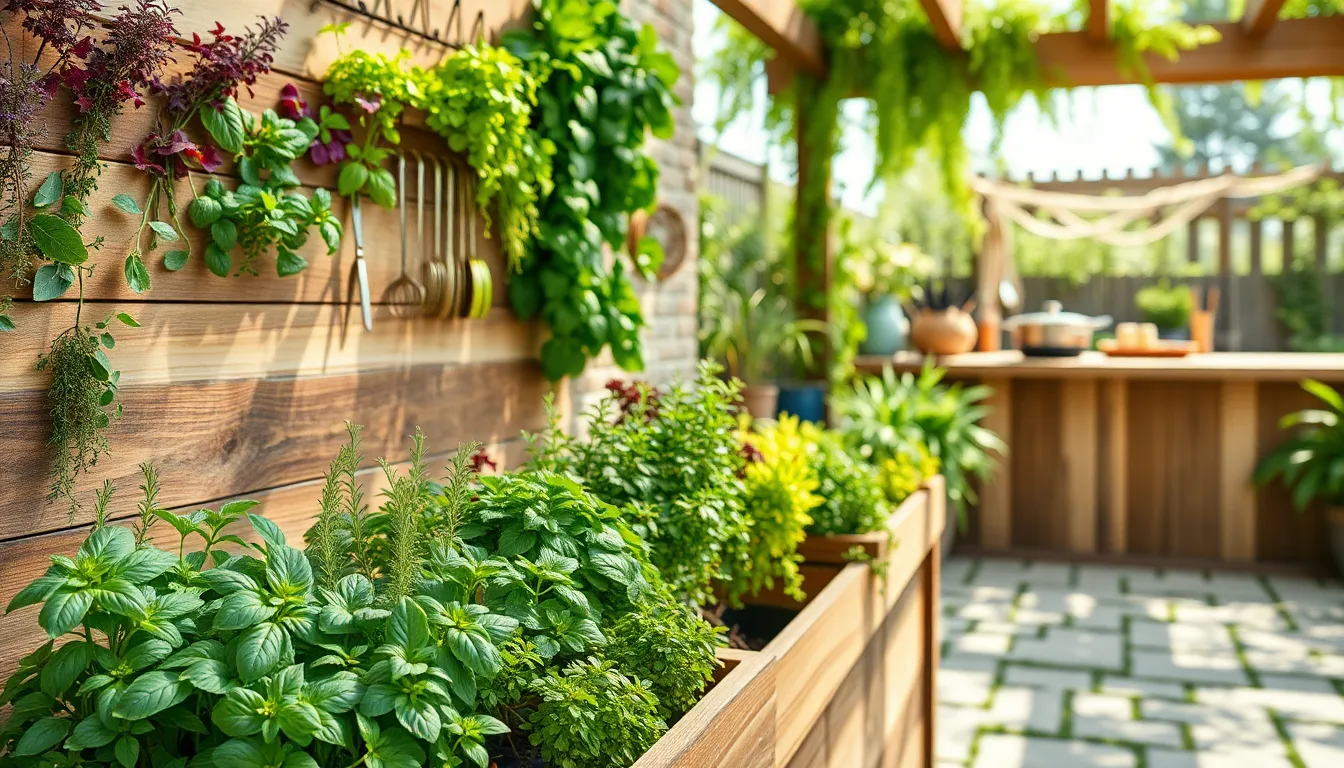
Adding fresh herbs to your garden kitchen design creates both culinary convenience and visual appeal. These aromatic additions provide immediate access to flavoring ingredients while improving the natural beauty of your outdoor cooking space.
Raised Bed Integration
Raised Bed Integration offers the most practical approach for growing herbs in garden kitchen environments. These elevated gardens provide superior drainage compared to ground level planting, preventing root rot in herbs like basil, rosemary, and thyme.
Building raised beds at counter height eliminates bending during harvest and maintenance activities. We recommend constructing beds 24 to 30 inches high for comfortable access while cooking. Cedar and composite materials resist weather damage better than traditional lumber options.
Strategic placement near prep stations maximizes convenience during meal preparation. Position herb beds within arm’s reach of cutting boards and cooking surfaces for seamless ingredient integration. Popular herb combinations include Mediterranean blends featuring oregano, sage, and lavender alongside culinary staples like parsley and chives.
Vertical Herb Walls
Vertical Herb Walls maximize growing space in compact garden kitchen areas while creating stunning living artwork. These space efficient structures can accommodate 15 to 20 different herb varieties in just 4 square feet of wall space.
Wood and metal frameworks provide the most durable foundation for vertical growing systems. Pressure treated cedar offers natural weather resistance, while powder coated steel frames withstand harsh outdoor conditions for decades. Modular pocket systems allow easy plant rotation and seasonal changes.
Installation requires proper drainage planning to prevent water damage to nearby surfaces. We suggest incorporating drip trays and overflow systems to manage excess moisture. Strategic lighting placement ensures even growth across all vertical levels, particularly important for sun loving herbs like Mediterranean varieties.
Container Garden Answers
Container garden answers deliver maximum flexibility for garden kitchen herb cultivation. These portable systems adapt to changing sunlight patterns throughout growing seasons while adding decorative elements through varied pot shapes, sizes, and colors.
Large containers measuring 12 inches or more in diameter support robust herb growth and reduce watering frequency. Terra cotta pots provide excellent drainage for Mediterranean herbs, while glazed ceramic containers retain moisture for herbs requiring consistent hydration like mint and cilantro.
Mobility allows optimization of growing conditions as seasons change. Move containers to capture morning sun for delicate herbs or afternoon shade for heat sensitive varieties. Rolling plant caddies enable easy repositioning of heavy containers without lifting strain.
Group plantings create attractive herb collections while simplifying care routines. Arrange containers at varying heights using plant stands and pedestals to maximize visual impact and accessibility during cooking activities.
Create Comfortable Seating and Dining Spaces
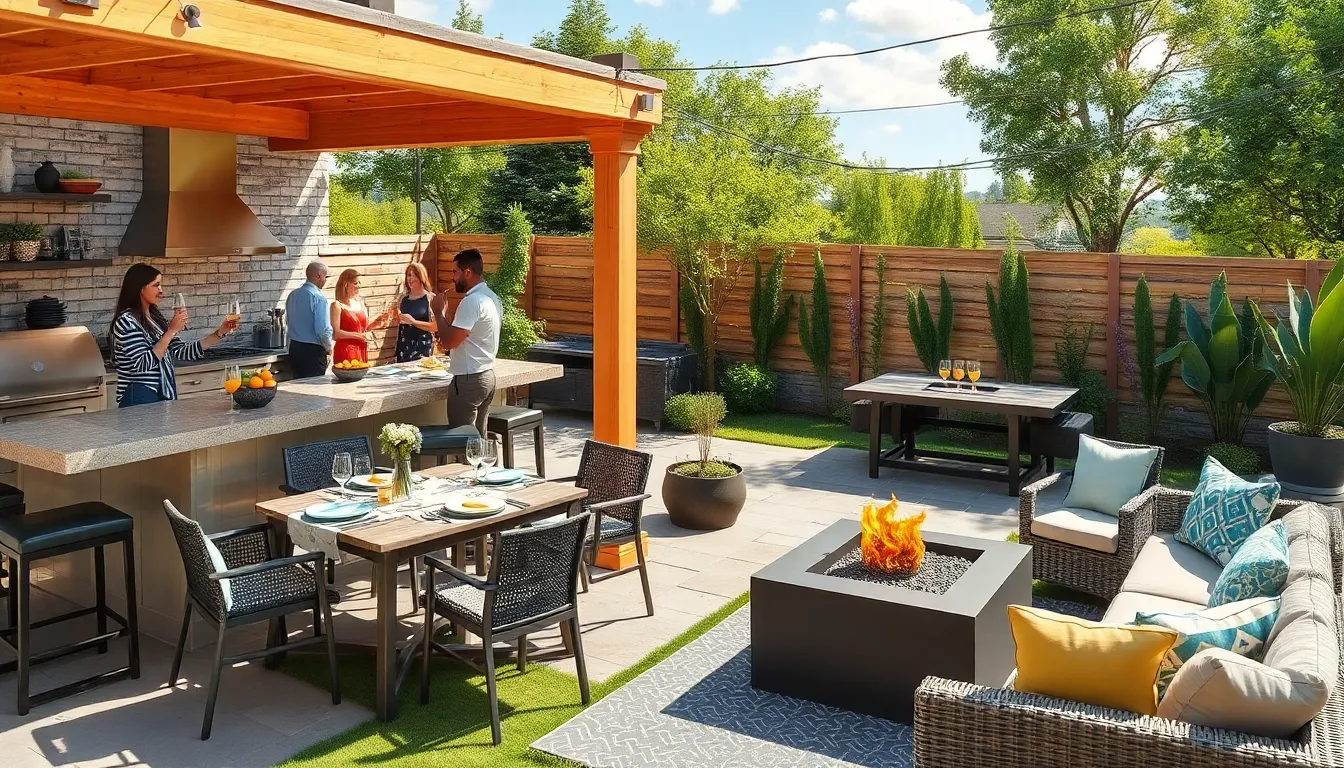
Garden kitchen seating areas transform outdoor cooking spaces into complete entertainment zones. We’ll explore three essential seating configurations that enhance both functionality and social interaction in your garden kitchen.
Bar Height Counter Seating
Counter seating creates the perfect casual gathering spot in your garden kitchen. We recommend incorporating bar height counters at 42 inches, which allows guests to socialize while you cook and prepare meals. This setup works exceptionally well when integrated with outdoor kitchen islands, providing additional prep space and serving areas.
Stools with weather resistant cushions offer comfort for extended conversations. We suggest choosing models with backs and footrests to maximize guest comfort during longer gatherings. The elevated position gives diners a better view of the cooking process, making meal preparation part of the entertainment.
Storage opportunities exist beneath counter seating areas. We often install wine coolers, extra storage drawers, or mini refrigerators in these spaces to keep beverages and supplies easily accessible. This configuration naturally encourages interaction between the cook and guests, creating a more social cooking experience.
Traditional Dining Table Areas
Formal dining areas provide an elegant centerpiece for garden kitchen spaces. We design these areas with tables that accommodate 6 to 8 people comfortably, creating a dedicated space for sit down meals and special occasions. Traditional dining setups work best when positioned 8 to 10 feet away from active cooking areas to prevent smoke and heat interference.
Covered patios and pergolas enhance the ambiance of traditional dining spaces. We recommend installing retractable awnings or permanent roof structures to protect diners from weather elements while maintaining the outdoor experience. These coverings also provide mounting points for ambient lighting and ceiling fans.
Table materials should match your overall garden kitchen aesthetic. We favor teak, aluminum, and weather resistant composites that maintain their appearance through various weather conditions. Round tables encourage conversation, while rectangular options maximize seating capacity for larger gatherings.
Casual Lounge Spaces
Relaxation zones complete the garden kitchen experience by providing comfortable areas for pre and post meal socializing. We create these spaces using outdoor sofas, deep seating chairs, and coffee tables that encourage guests to linger and enjoy the outdoor environment. Positioning lounge areas 12 to 15 feet from active cooking zones ensures comfort while maintaining connection to kitchen activities.
Weather resistant cushions and fabrics are essential for lounge furniture longevity. We recommend solution dyed acrylic fabrics that resist fading, mold, and moisture while providing comfort comparable to indoor furniture. Quick drying foam inserts prevent water retention and maintain cushion shape over time.
Fire features enhance lounge spaces by extending usability into cooler evenings. We often incorporate fire pits, fire tables, or outdoor fireplaces as focal points that provide warmth and ambiance. These elements create natural gathering spots and extend the outdoor season for your garden kitchen entertainment.
Add Weather Protection Elements
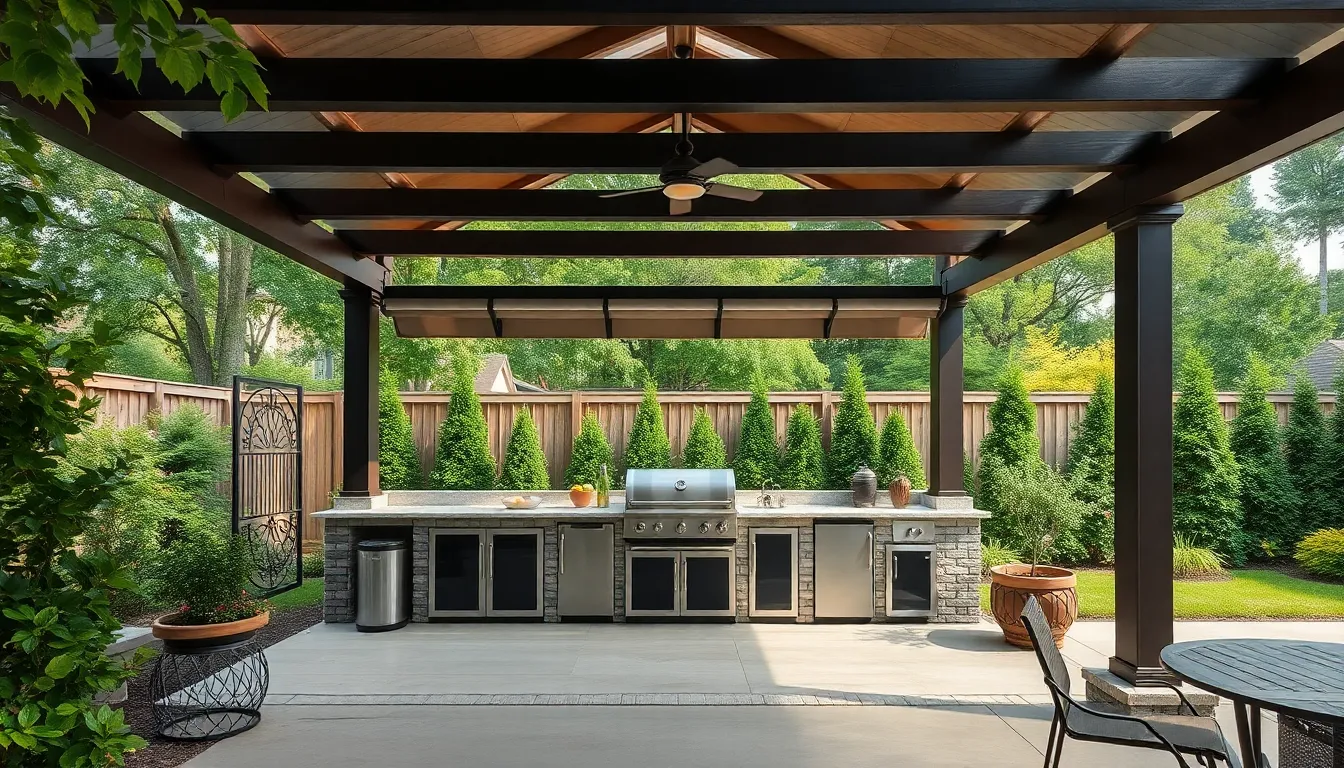
Weather protection transforms garden kitchens from seasonal spaces into year-round culinary havens that withstand nature’s elements.
Pergolas and Gazebos
Pergolas offer the perfect balance of shade and openness for garden kitchen spaces. These attractive structures provide dappled sunlight during cooking while creating defined outdoor rooms. We recommend modifying basic pergolas with waterproof covers to shield against rain and hail damage. Installation remains straightforward with most pergola kits, making them accessible for weekend DIY projects.
Gazebos deliver more comprehensive coverage than their pergola counterparts. These enclosed structures create fully protected cooking zones suitable for areas requiring substantial weather protection. Built in gazebos often feature integrated roofing systems and sidewalls that block wind and precipitation effectively.
Retractable Awnings
Retractable awnings provide unmatched flexibility for changing weather conditions throughout the day. Extended awnings create instant shade on hot summer days while protecting outdoor appliances from harmful UV rays. Quick deployment capabilities allow you to shield cooking areas from sudden rain showers within seconds.
Motorized retractable systems offer convenience at the touch of a button. Manual versions cost less while still delivering effective weather protection for budget conscious garden kitchen projects. We find that awnings work best when positioned to cover primary cooking and prep zones where weather exposure poses the greatest risk.
Windbreak Answers
Decorative screens serve dual purposes by blocking wind while adding visual appeal to garden kitchen designs. These versatile barriers can be positioned strategically around cooking areas to reduce wind interference with grills and open flames. Installation flexibility allows you to move screens as needed based on seasonal wind patterns.
Lattice work provides natural wind barriers that complement garden aesthetics perfectly. These structures offer partial wind protection while maintaining air circulation around cooking areas. We recommend combining lattice panels with climbing plants to create living windbreaks that enhance both function and beauty in garden kitchen spaces.
Install Adequate Electrical and Gas Connections
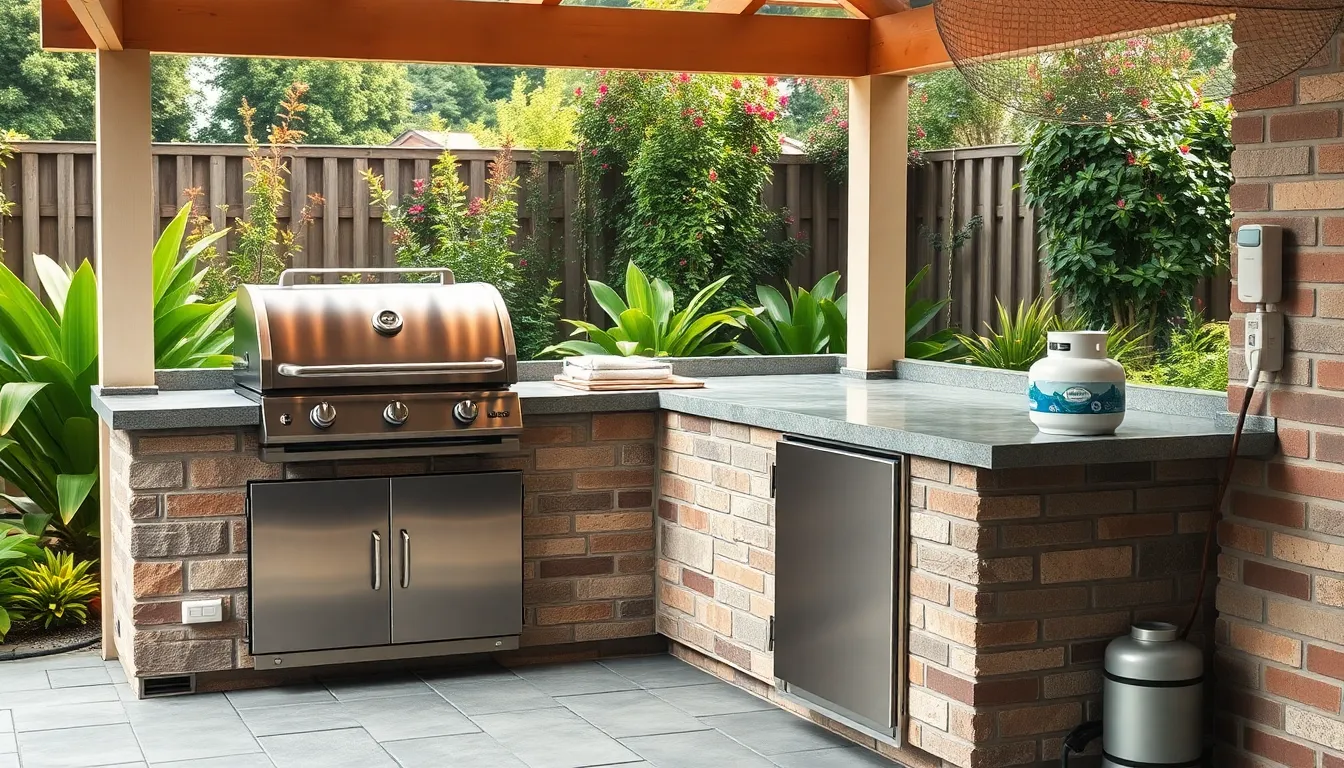
Creating a safe and functional garden kitchen requires proper electrical and gas infrastructure that meets code requirements and supports your outdoor cooking needs.
GFCI Outlet Requirements
GFCI outlets protect against electrical shock from water exposure in outdoor cooking environments. We recommend installing Ground Fault Circuit Interrupter outlets as they’re crucial for safety and required by local building codes for outdoor kitchens.
Heavy duty wiring supports high demand appliances like grills and smokers without overloading your electrical system. Each major appliance should have its own dedicated circuit to prevent electrical issues and maintain optimal performance.
Additional outlets accommodate smaller appliances such as blenders, food processors, and device chargers that enhance your outdoor cooking experience. Planning for extra electrical capacity ensures you won’t run short of power when entertaining guests.
Natural Gas Line Installation
Professional installation ensures safety compliance with local building codes including the International Residential Code (IRC). We strongly advise hiring trained professionals rather than attempting DIY gas line installation due to safety risks.
Material protection extends system longevity through proper maintenance of gas line components. Common black iron gas pipes should be painted to protect them from corrosion and weather damage in outdoor environments.
Code compliance verification prevents costly mistakes and ensures your garden kitchen meets all regulatory requirements. Local authorities can provide exact guidelines for gas line installation in your area.
Propane Tank Storage
Safe placement requires well ventilated areas away from heat sources and ignition points throughout your garden kitchen space. Following local regulations for tank size and placement restrictions protects both your property and family.
Regulator requirements vary by tank size and may include inline regulators for larger propane tanks like 250 gallon systems. Professional consultation helps determine exact regulator needs for your gas flow requirements.
Storage accessibility balances safety with convenience by positioning tanks where they’re easily serviceable yet properly distanced from cooking areas. Consider creating dedicated storage compartments that protect tanks while maintaining proper ventilation.
Conclusion
Creating your dream garden kitchen is an exciting journey that brings together the best of outdoor living and culinary passion. We’ve explored how the right combination of durable appliances weather-resistant materials and thoughtful design can transform any outdoor space into a functional cooking paradise.
From selecting the perfect grill and prep surfaces to incorporating fresh herb gardens and comfortable seating areas your garden kitchen will become the heart of your outdoor entertainment space. The key lies in balancing functionality with natural beauty while ensuring proper infrastructure supports your culinary adventures.
With careful planning and attention to details like lighting drainage and weather protection you’ll create an outdoor cooking environment that enhances both your gardening productivity and your love for preparing fresh seasonal meals. Your garden kitchen awaits – it’s time to start building your outdoor culinary dream.
Frequently Asked Questions
What is a garden kitchen and how is it different from a regular outdoor cooking area?
A garden kitchen is a functional outdoor cooking space that integrates seamlessly with your garden environment, emphasizing the use of seasonal ingredients and creating a connection to food sources. Unlike basic outdoor cooking setups, garden kitchens combine practical cooking appliances with natural beauty, often incorporating herb gardens and fresh produce growing areas directly into the design for a complete culinary experience.
What are the essential appliances needed for a garden kitchen?
Essential appliances include built-in grills and smokers (preferably stainless steel for durability), outdoor pizza ovens for restaurant-quality results, and portable induction cooktops for precise cooking control. These appliances should be designed to withstand outdoor conditions and offer versatility in cooking methods, from grilling and smoking to baking and precision cooking without requiring gas lines.
What materials work best for garden kitchen countertops and surfaces?
Natural stone countertops like granite, marble, and quartzite are ideal due to their exceptional durability and low maintenance requirements. Stainless steel components offer excellent corrosion resistance and easy cleaning, making them perfect for outdoor appliances and sinks. Composite decking materials work well for flooring as they resist rot and insect damage while providing slip-resistant surfaces.
How important is water access and drainage in garden kitchens?
Water access is critical for transforming an outdoor space into a fully functional culinary environment. Outdoor sinks provide convenient water access for food prep and cleanup, with installation options ranging from simple garden hose connections to built-in systems. Proper drainage systems prevent water accumulation and maintain cleanliness, requiring professional installation to ensure compliance with local regulations.
What lighting options work best for garden kitchens?
Strategic lighting enhances both functionality and ambiance for day and night use. Task lighting like under-counter strip lights and wall sconces improve visibility during food preparation. Ambient lighting including string lights and weather-resistant lanterns create inviting dining atmospheres. Solar-powered lighting solutions offer energy-efficient illumination without electrical connections, perfect for remote garden locations.
How can I incorporate fresh herbs into my garden kitchen design?
Fresh herb gardens can be integrated through raised beds (24-30 inches high for easy access), vertical herb walls for space efficiency, or container gardening for flexibility. Materials like cedar and composite work well for raised beds due to their durability. Container gardens allow for optimal sunlight exposure and decorative arrangements while providing mobility for seasonal changes.
What seating and dining options work best in garden kitchens?
Three essential configurations include bar height counter seating for casual gatherings, traditional dining table areas for formal meals, and casual lounge spaces for relaxation. Weather-resistant furniture is crucial, and including fire features extends usability into cooler evenings. Each configuration should complement the overall garden kitchen aesthetic while enhancing social interaction and functionality.
How can I protect my garden kitchen from weather elements?
Weather protection options include pergolas and gazebos for shade and element protection, with waterproof covers for added durability. Retractable awnings offer flexibility for changing weather conditions. Decorative screens and lattice work serve as effective windbreaks while enhancing aesthetics. These elements help transform garden kitchens into year-round culinary spaces.
What electrical and gas considerations are important for garden kitchens?
GFCI outlets are essential to protect against electrical shock, and heavy-duty wiring is needed for high-demand appliances. Professional installation of natural gas lines ensures safety compliance and proper maintenance. Propane tank storage requires safe placement and accessibility while adhering to local regulations. Professional installation is recommended to ensure proper connections and code compliance.

